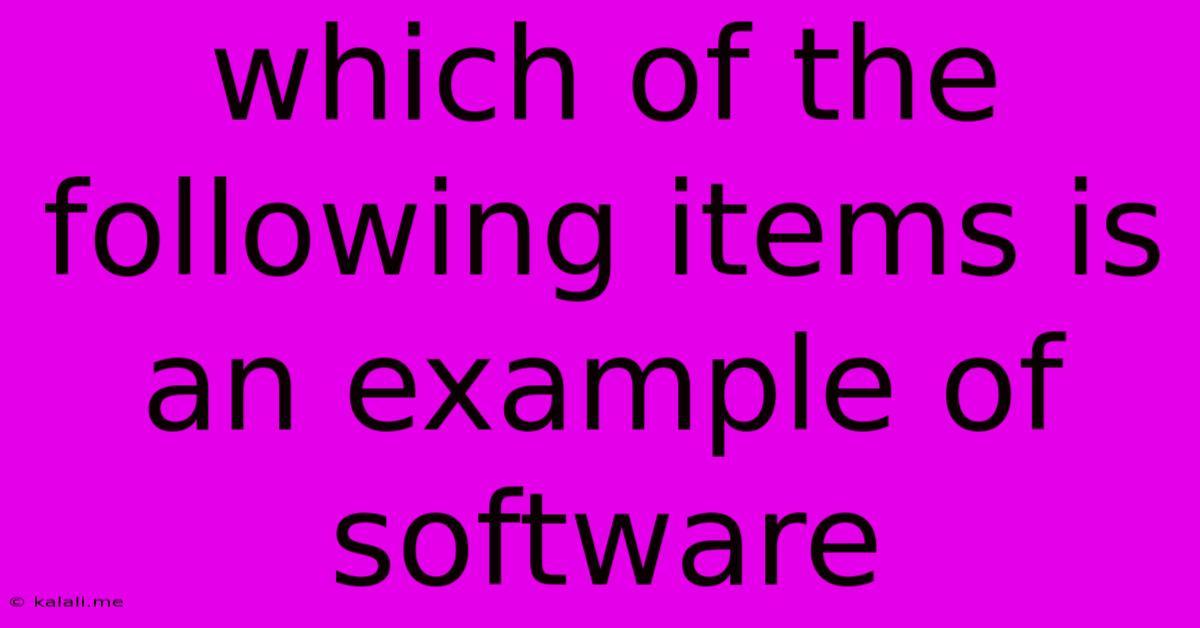Which Of The Following Items Is An Example Of Software
Kalali
Jun 15, 2025 · 3 min read

Table of Contents
Which of the following items is an example of software? Understanding the Difference Between Hardware and Software
This article will explore the fundamental difference between hardware and software and help you identify which items from a given list would be classified as software. Understanding this distinction is crucial in the digital age, as both are essential components of any computer system. This article will provide a clear definition and examples to solidify your understanding.
What is Software?
Simply put, software is a set of instructions, data, or programs used to operate computers and execute specific tasks. Unlike hardware, which you can physically touch, software is intangible – a collection of code that tells the hardware what to do. Think of it as the brain of a computer system, directing the physical components to perform various functions. Examples include operating systems, applications, and programming languages.
What is Hardware?
In contrast, hardware refers to the physical components of a computer system. These are the tangible parts you can see and touch, such as the monitor, keyboard, mouse, central processing unit (CPU), and hard drive. Hardware provides the platform on which software operates.
Identifying Software from a List
Now, let's consider how to identify software from a list of items. Here's a breakdown of characteristics to look for:
- Functionality: Software provides functionality. It performs tasks, processes data, or controls other components.
- Intangibility: Software is intangible; you can't physically touch it. It exists as code stored on a physical medium like a hard drive.
- Instructions: Software consists of a set of instructions (code) that dictate the actions of the hardware.
Examples of Software:
- Operating Systems (OS): Windows, macOS, Linux, Android, iOS – these are fundamental software that manage all other software and hardware resources. These are the foundation upon which applications run.
- Applications: Microsoft Word, Adobe Photoshop, Google Chrome, games – these are programs designed to perform specific tasks for the user. This is the software most users interact with directly.
- Programming Languages: Python, Java, C++, JavaScript – these are tools used by developers to create software. They are the building blocks for all other software.
- Drivers: These are small programs that allow the computer to communicate with hardware devices like printers and scanners. They are often bundled with the hardware but are themselves software.
- Databases: MySQL, PostgreSQL, Oracle – these software applications store and manage large amounts of data.
Examples of Hardware:
- Central Processing Unit (CPU): The "brain" of the computer, performing calculations.
- Random Access Memory (RAM): Temporary storage for data the CPU is actively using.
- Hard Disk Drive (HDD) or Solid State Drive (SSD): Permanent storage for data and software.
- Motherboard: The main circuit board connecting all components.
- Graphics Processing Unit (GPU): Processes visual information.
Conclusion:
Distinguishing between software and hardware is a fundamental concept in computer science. Remember that software provides the instructions, while hardware provides the physical platform. By understanding these core differences and looking for characteristics such as functionality and intangibility, you can confidently identify software from a list of items. This knowledge is essential for anyone navigating the digital world.
Latest Posts
Latest Posts
-
Which Is The Longest Phase Of Mitosis
Jun 15, 2025
-
For A Given Wave If The Frequency Doubles The Wavelength
Jun 15, 2025
-
The Founding Playwright Of The Realist Era Was
Jun 15, 2025
-
Consider The Circuit Shown In The Figure
Jun 15, 2025
-
Which Of The Following Are Characteristics Of Service Provider Operations
Jun 15, 2025
Related Post
Thank you for visiting our website which covers about Which Of The Following Items Is An Example Of Software . We hope the information provided has been useful to you. Feel free to contact us if you have any questions or need further assistance. See you next time and don't miss to bookmark.